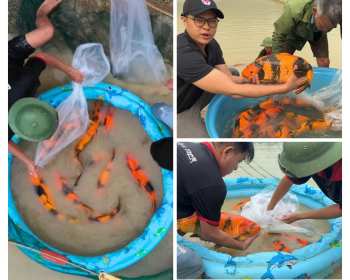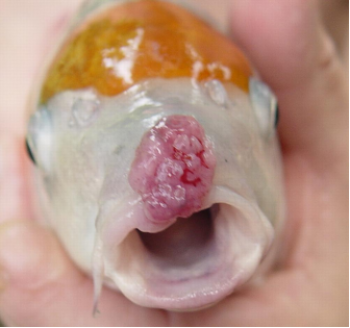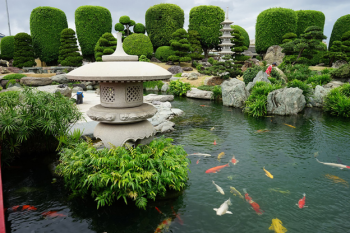1. Anchor worm
Anchor worms are one of the most common diseases in Koi fish. The disease is caused by a type of crustacean parasite, known in English as Lernea – Anchor Worm. This parasite clings to the body and tail of the koi, which is easily visible to the naked eye. At a young age, the anchor worm lives in the koi gills, the adult stage of the male and the female mate, then the male will leave the koi gills to live for a few days in the water and then die.

When fish have this disease, they are often lazy to eat, itchy, irritable, emaciated, and slow to swim. The wounds caused by anchor worms create conditions for fungi and bacteria to attack, making the disease more and more severe.

Treatment: Use Ivermectin to treat, combine fungal treatment with Broponol (2 times 10 days apart). During the cultivation process, periodically 20 days of treatment for parasite disease prevention with a dosage of 100ml/5000 m3 of water.
One of the causes of anchor worms in koi fish is that the water source is not guaranteed. Therefore, farmers need to pay attention to learning and fully equipping koi lake water purifiers, removing dirt and harmful microorganisms – pathogens for koi fish.
2. Fish lice disease
Fish lice parasitize on the skin, fins, body, oral sinuses, koi gills. They suck blood, and at the same time secrete toxins that cause fish to be damaged and swollen red, creating conditions for bacteria, fungi, and other parasites to invade and cause diseases. Fish lice often suck blood at night, making koi itchy and uncomfortable, often swimming around.

Treatment: When seeing that Koi fish appear a lot of lice on the body of the fish, Koi fish farmers use bactericidal solutions: potassium permanganate, povidine, bentadine, iodine... splash into the pond or apply to the damaged areas continuously for 5-7 days.
3. White spot disease
Koi fish suffer from white spot disease relatively commonly. When sick, white seeds will appear on the body and head of the fish and spread very quickly to other parts, from one fish to another. Detecting sick fish, it is best for farmers to isolate fish from the lake/tank to avoid spreading. The fungus will stick to the tissues and skin of the fish, making the fish sick. The cause of white spot disease in Koi fish is that the water source is polluted, not ensuring a clean water environment for fish to grow

How to handle:
- Increase the salt concentration in the lake/koi tank to 0.5%/day, maintain the temperature in the tank at 27 degrees Celsius (use a heating lamp during the treatment)
- Dissolve 3-5 drops of methylene green (available at pharmacies) in 20 liters of water and change the water once a day.
After treating koi fish with white spots, the fish will often be weak, the color of the fish will be less beautiful, at this time, farmers need to pay attention to strengthening tonics so that the fish in the lake/tank are more beautiful and healthy.
4. Red spot disease
Signs of this disease are red hemorrhagic dots all over the fish's body, scales fall off in patches, fish stop eating, swim lethargy on the water. When the disease becomes severe, the roots, fin rays are torn and gradually extinct. The skin hemorrhagic areas are inflamed, smeared and ulcerated, pusty, surrounded by parasitic fungi, pale gills, and hemorrhagic protruding ankles.

In the North, red spot disease in Koi fish usually appears in spring (March-April) and autumn (August-September).
How to treat: If you raise in a pond, replace the pond with new water, periodically apply lime with CaCO3 mixed with water for 20 days, pour evenly all over the pond with a dosage of 2 kg/100m2 to stabilize the pH concentration in the water environment (because this type of bacteria does not adapt in an alkaline environment). On top of the tank, treat 15-20 g of Tetraxylin + 3 kg of salt / 1m3 of water maintained for 3 days.
5. Tail rot
Signs of a sick koi fish :p swollen and inflamed tail fin, peeling, aggravated by necrosis and decay of the meat muscles, blood stasis at the base of the tail fin.

Myxcobacteria and mold infections are the main causes of this disease. 2 pathways lead to bacterial infection: 1 is the accumulated and untreated fish waste causing disease outbreaks, 2 is the density of koi farming is too thick, the water purifier is not guaranteed, and the water quality is not ideal.
Treatment: Strong germicidal with biocidal solutions such as Iodine, BKC,... with the dosage according to the manufacturer. For the tank, use 1% Malachite green solution applied to the lesions on the tail fin, apply 1 time a day, apply continuously for 4-5 days.
6. Skin fluke, gill flukes
Signs of fish disease: the swimming posture is not straight but swaying, often spurs the body to the bottom or the edge of the tank/lake, convulsions due to itching, or jumping out of the water. Fish blood-sucking helminths cause scabies and perforation of fish gills, if not treated early, it will cause fish to die.

Skin flukes and koi worms occur due to the quality of dirty lake water/aquarium, poor oxygen content in the tank, and high concentration of organic matter.
How to prepare: disinfect water sources with Ivermectin solutions, mix Tetraxylin feeding fish with a dosage of 4g/kg of feed. Continuous feeding for 5-7 days.
7. Ulcers
Signs: collision wounds, bacterial infections will lead to infection and the appearance of ulcers on the skin. If these marks are not treated soon, they will cause fish to die.

Treatment: Disinfect water sources with iodine solution, BKC, heart medicine,... Then mix Tetrãilin at a dosage of 6 g/kg of feed. If it is on the tank, the water source must be disinfected, then the fish must be bathed to apply potassium permanganate, soaked in the antibiotic tetrãilin at a dosage of 15g/m3 of water.
8. Rough scab disease
Signs of the disease: the body of the fish is swollen, the eyes bulge, the scales of the fish are raised, making the fish shaped like a pine cone. Koi will eat little and swim near the water, where there is plenty of oxygen.

Fish are infected with bacteria that cause internal bleeding. There are parasites in the fish or tumors in the fish that grow that swell.
The disease can occur at any time, usually with the whole herd at a time. Some parasites affect the kidneys of fish, causing them to lose their function.
Treatment: Fish should be separated for treatment with a salt concentration of 5 kg/m3 of water. for 5 consecutive days. Combine VMT C enhancement with a dosage of 20 g/m3 of water to increase the resistance of fish.





